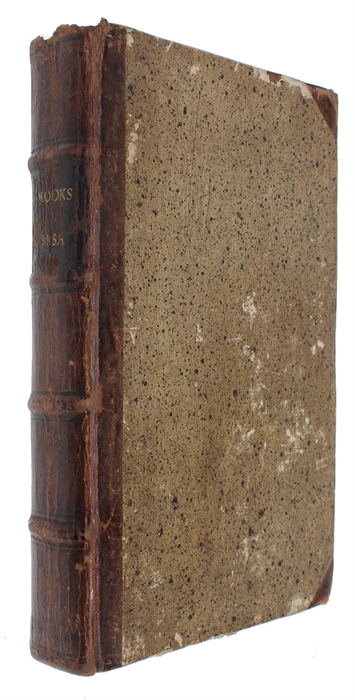FIRST SWEDISH TRANSLATION OF COOK'S SECOND VOYAGE
COOK, JAMES (+) GEORG FORSTER (+) TOBIAS FURNEAUX.
Sammandrag af Capitain Jacob Cooks åren 1772, 73, 74 och 1775 omkring Södra Polen förrättade resa : hwarwid Herrar Forsters och Furneaux journaler blifwit jämnförde och nyttjade : Innehållande det hufwudsakeligaste af de på denna resa gjorda nya uptäckter i söderhafwet, Rörande Södra Polens Ishaf nya uptäckte Öars naturalier och Inwånarnes Tänkesätt, Seder, Klädedrägt, m.m. [i.e. Swedish "A Voyage towards the South Pole", translated by Samuel Ödmann].
Upsala, Johan Edman, 1783. 8vo. In contemporary half calf with four raised bands. Previous owner's name to front free end-paper and half-title. Wear to extremities, internally fine and clean. (24), 366, (10) pp.
First Swedish translation of the official account of Cook's second voyage and Georg Forster's unofficial Voyage round the World.
"Cook earned his place in history by opening up the Pacific to western civilization and by the foundation of British Australia. The world was given for the first time an essentially complete knowledge of the Pacific Ocean and Australia, and Cook proved once and for all that there was no great southern continent, as had always been believed. He also suggested the existence of antarctic land in the southern ice ring, a fact which was not proved until the explorations of the nineteenth century" (Printing and the Mind of Man p.135).
"The success of Cook's first voyage led the Admiralty to send him on a second expedition, described in the present work, which was to circumnavigate the globe as far south as possible in search of any southern continents. The men of this expedition became the first to cross the Antarctic Circle. Further visits were made to New Zealand, and on two great sweeps Cook made an astonishing series of discoveries and rediscoveries including Easter Island, the Marquesas, Tahiti and the Society Islands, Niue, the Tonga Islands, the New Hebrides, New Caledonia, Norfolk Island, […] Cook discovered and charted South Georgia, after which he called at Cape Town, St. Helena and Ascension, and the Azores. This voyage produced a vast amount of information concerning the Pacific peoples and islands, proved the value of the chronometer as an aid to finding longitude, and improved techniques for preventing scurvy" (Hill p.123)
Order-nr.: 55314


